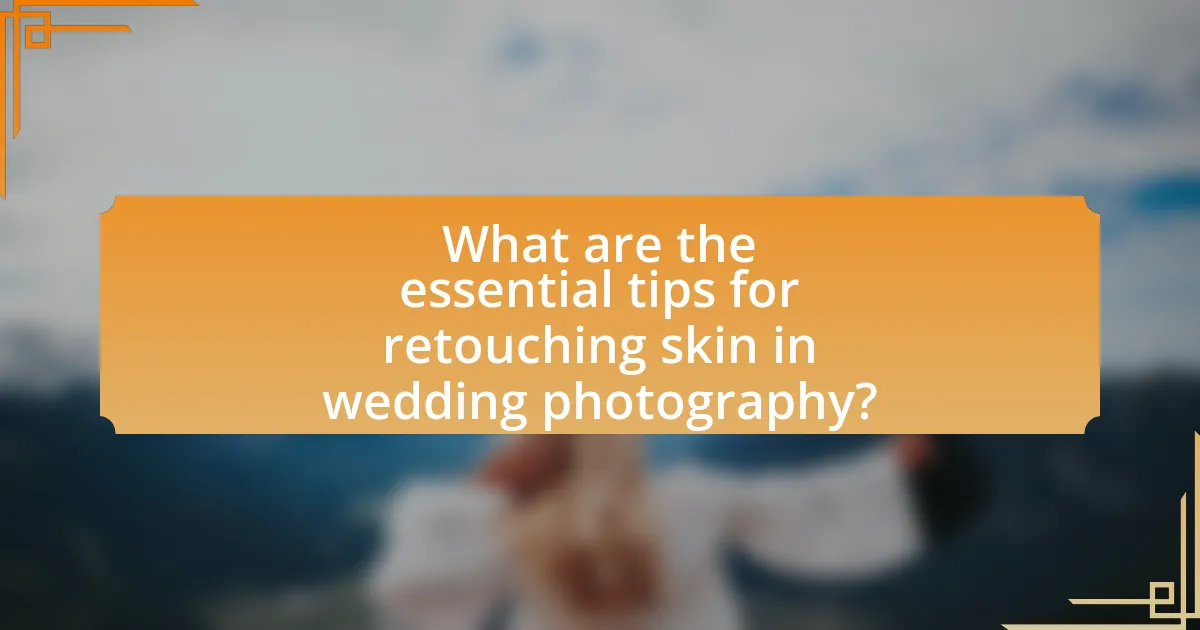The article focuses on essential tips for retouching skin in wedding photography while maintaining natural beauty. Key techniques discussed include frequency separation, subtle color correction, and the importance of preserving skin texture to avoid an artificial appearance. The article emphasizes the role of lighting in enhancing skin retouching and outlines common mistakes to avoid, such as over-smoothing and inconsistent skin tones. Additionally, it highlights the significance of using appropriate software tools and presets to achieve a cohesive editing style, while also addressing how client feedback can influence retouching decisions. Overall, the article provides practical guidance for photographers to enhance their subjects’ beauty authentically.

What are the essential tips for retouching skin in wedding photography?
Essential tips for retouching skin in wedding photography include using frequency separation, maintaining skin texture, and applying subtle color correction. Frequency separation allows photographers to separate texture from color, enabling precise adjustments without losing the natural look of the skin. Maintaining skin texture is crucial; over-smoothing can lead to an artificial appearance, so it’s important to keep some natural imperfections. Subtle color correction helps to balance skin tones, ensuring that the final image reflects the true colors of the subject. These techniques are widely recognized in professional photography, as they enhance the beauty of the subject while preserving authenticity.
How can retouching enhance the natural beauty of the subject?
Retouching enhances the natural beauty of the subject by refining skin texture, correcting imperfections, and balancing tones without altering the subject’s inherent features. This process allows for the removal of blemishes, smoothing out uneven skin, and enhancing the overall complexion, which results in a polished yet authentic appearance. Studies in photography and digital editing emphasize that subtle retouching can improve visual appeal while preserving the subject’s unique characteristics, ensuring that the final image reflects both beauty and authenticity.
What techniques can be used to achieve a natural look?
To achieve a natural look in wedding photography, techniques such as subtle skin retouching, using soft lighting, and applying minimal makeup are essential. Subtle skin retouching involves reducing blemishes and imperfections without over-smoothing, which can lead to an unnatural appearance. Soft lighting enhances the subject’s features while minimizing harsh shadows, creating a more flattering and natural effect. Additionally, applying minimal makeup allows the subject’s natural beauty to shine through, ensuring that the final image reflects their true self. These techniques collectively contribute to a realistic and authentic representation in wedding photography.
How does lighting affect skin retouching in photography?
Lighting significantly affects skin retouching in photography by influencing the visibility of skin texture and imperfections. Proper lighting can enhance the natural glow of the skin, making it easier to achieve a balanced retouch that maintains authenticity. For instance, soft, diffused lighting minimizes harsh shadows and highlights, which can reveal blemishes and uneven skin tone, thus allowing for smoother retouching. Conversely, harsh lighting can exaggerate imperfections, making retouching more challenging and potentially leading to an unnatural appearance. Studies in photography emphasize that the quality of light directly impacts the final image quality, reinforcing the importance of lighting in achieving effective skin retouching.
What common mistakes should be avoided in skin retouching?
Common mistakes to avoid in skin retouching include over-smoothing, which can lead to an unnatural appearance, and neglecting to preserve skin texture, resulting in a plastic-like effect. Over-smoothing often occurs when excessive use of blur tools is applied, diminishing the subject’s unique features. Additionally, failing to adjust color tones can create an inconsistent skin tone, making the retouching look artificial. Maintaining a balance between correction and authenticity is crucial; studies show that viewers prefer images that retain some natural imperfections over overly retouched ones.
How can over-editing impact the final image?
Over-editing can significantly degrade the quality of the final image by creating an unnatural appearance. When excessive adjustments are made, such as over-smoothing skin or altering colors too drastically, the image can lose its authenticity and realism. This is particularly critical in wedding photography, where capturing genuine emotions and moments is essential. Studies have shown that images with excessive editing often receive negative feedback from viewers, as they can appear artificial and detract from the subject’s true beauty.
What are the signs of unnatural skin retouching?
Signs of unnatural skin retouching include overly smooth skin texture, loss of natural skin features, and inconsistent skin tone. Overly smooth skin often appears plastic-like, lacking pores or fine lines, which are essential for realism. Loss of natural features, such as freckles or blemishes, can make the subject look artificial, as these details contribute to individual character. Inconsistent skin tone, where certain areas appear unnaturally uniform or overly bright, can also indicate excessive editing, as natural skin typically has variations in color and texture. These signs collectively suggest that the retouching process has compromised the authenticity of the image.

How can different tools and software aid in skin retouching?
Different tools and software can significantly enhance skin retouching by providing advanced features for editing and refining images. Software like Adobe Photoshop offers tools such as the Healing Brush and Clone Stamp, which allow for precise removal of blemishes and imperfections while preserving skin texture. Additionally, Lightroom provides options for adjusting skin tones and smoothing skin without losing detail, utilizing features like the Adjustment Brush and Radial Filter. These tools enable photographers to achieve a polished look while maintaining the subject’s natural beauty, as evidenced by the widespread use of these applications in professional photography.
What are the best software options for skin retouching?
The best software options for skin retouching include Adobe Photoshop, Lightroom, and Capture One. Adobe Photoshop is widely recognized for its advanced retouching tools, such as the Healing Brush and Clone Stamp, which allow for precise skin corrections. Lightroom offers excellent color correction and basic retouching features, making it user-friendly for photographers. Capture One is favored for its powerful color grading and skin tone adjustments, providing a high level of detail and control. These software options are commonly used by professional photographers to enhance skin while preserving a natural appearance.
How do different tools within software contribute to natural results?
Different tools within software contribute to natural results by providing precise control over image editing parameters, allowing for subtle adjustments that enhance rather than alter the original appearance. For instance, tools like frequency separation enable editors to smooth skin texture while preserving natural skin tones, which is crucial in wedding photography where authenticity is valued. Additionally, software features such as selective color correction and dodge and burn techniques allow for targeted enhancements, ensuring that the final image retains a lifelike quality. Studies in digital image processing have shown that careful manipulation of these tools can lead to results that are perceived as more natural by viewers, thus reinforcing the importance of using the right software tools in achieving aesthetically pleasing yet realistic outcomes in photography.
What features should photographers look for in retouching software?
Photographers should look for features such as advanced skin retouching tools, layer management, and non-destructive editing capabilities in retouching software. Advanced skin retouching tools allow for precise adjustments to skin texture and tone, which is essential for maintaining natural beauty in wedding photography. Layer management enables photographers to organize edits effectively, facilitating easy adjustments without losing original image quality. Non-destructive editing capabilities ensure that all changes can be reverted or modified at any time, preserving the integrity of the original photograph. These features collectively enhance the retouching process, allowing photographers to achieve professional results while keeping the subject’s natural appearance intact.
How can photographers maintain a consistent style in skin retouching?
Photographers can maintain a consistent style in skin retouching by developing and adhering to a specific set of editing guidelines and techniques. This involves creating a standardized workflow that includes the use of particular software settings, filters, and brushes that align with their artistic vision. For instance, utilizing the same frequency separation technique or skin smoothing presets across all images ensures uniformity in texture and tone. Additionally, regularly reviewing and comparing edited images helps photographers identify and correct any deviations from their established style, reinforcing consistency.
What role does a photographer’s editing style play in skin retouching?
A photographer’s editing style significantly influences skin retouching by determining the balance between enhancing features and preserving natural appearance. This style dictates the techniques used, such as frequency separation or dodging and burning, which can either create a polished look or lead to an artificial appearance. For instance, a photographer who favors a soft, natural aesthetic may opt for minimal retouching, focusing on subtle adjustments that maintain skin texture, while another who prefers a high-glamour style might employ more aggressive smoothing techniques. Studies in photography emphasize that consistent editing styles contribute to a recognizable brand identity, impacting client expectations and satisfaction in wedding photography.
How can presets be used effectively for skin retouching?
Presets can be used effectively for skin retouching by applying consistent adjustments that enhance skin tones and textures while preserving natural features. Utilizing presets allows photographers to streamline their workflow, ensuring that skin retouching maintains a uniform look across images. For instance, presets can include adjustments for skin smoothing, color correction, and blemish removal, which can be fine-tuned to avoid over-processing. Studies show that consistent editing styles contribute to a cohesive visual narrative in wedding photography, making presets a valuable tool for achieving this goal.

What are the best practices for retouching skin while preserving authenticity?
The best practices for retouching skin while preserving authenticity include using subtle adjustments, maintaining texture, and focusing on natural skin tones. Subtle adjustments, such as reducing blemishes and smoothing skin, should be done with tools that allow for fine control, ensuring that the skin retains its natural appearance. Maintaining texture is crucial; over-smoothing can lead to an artificial look, so techniques like frequency separation can help retain skin detail while correcting imperfections. Additionally, preserving natural skin tones involves careful color correction to avoid unnatural hues, ensuring that the final image reflects the subject’s true complexion. These practices are supported by industry standards that emphasize the importance of authenticity in portrait photography, particularly in wedding photography where capturing genuine moments is essential.
How can feedback from clients influence retouching decisions?
Feedback from clients significantly influences retouching decisions by providing insights into their preferences and expectations. When clients express specific likes or dislikes regarding skin texture, blemish removal, or overall aesthetics, retouchers can adjust their techniques to align with these preferences. For instance, if a client prefers a more natural look with minimal alterations, the retoucher can focus on subtle enhancements rather than heavy editing. This client input ensures that the final images resonate with their vision, ultimately leading to higher satisfaction and a more personalized outcome.
What questions should photographers ask clients regarding their preferences?
Photographers should ask clients about their preferences regarding skin retouching techniques, desired levels of natural appearance, and specific features they want to highlight or minimize. Understanding whether clients prefer a more polished look or a natural finish is crucial, as it directly influences the retouching process. Additionally, inquiring about any particular skin concerns, such as blemishes or uneven tone, helps tailor the approach to meet individual needs. This targeted questioning ensures that the final images align with the clients’ expectations and maintain the essence of natural beauty, which is essential in wedding photography.
How can photographers balance client expectations with artistic vision?
Photographers can balance client expectations with artistic vision by establishing clear communication and setting realistic boundaries from the outset. This involves discussing the client’s desires and preferences while also sharing the photographer’s unique style and approach. For instance, a photographer might present a portfolio that highlights their artistic vision, allowing clients to understand the aesthetic they can expect. Additionally, incorporating client feedback during the creative process can help align both parties’ visions, ensuring that the final product satisfies the client’s expectations while still reflecting the photographer’s artistry. This method is supported by industry practices that emphasize collaboration, which has been shown to enhance client satisfaction and artistic integrity in photography.
What practical tips can photographers implement for effective skin retouching?
Photographers can implement several practical tips for effective skin retouching, including using frequency separation, adjusting skin tones, and maintaining texture. Frequency separation allows photographers to separate the skin’s color and texture, enabling precise adjustments without losing natural detail. Adjusting skin tones involves using color correction tools to ensure even skin color while avoiding an unnatural look. Maintaining texture is crucial; photographers should avoid excessive smoothing, which can lead to a plastic appearance. These techniques are widely recognized in professional photography, as they help achieve a balance between enhancing beauty and preserving authenticity.
How can photographers develop a retouching workflow that saves time?
Photographers can develop a retouching workflow that saves time by utilizing presets and batch processing techniques. By creating or using existing presets in software like Adobe Lightroom or Photoshop, photographers can apply consistent adjustments across multiple images quickly, reducing the need for repetitive manual edits. Batch processing allows for the simultaneous editing of several photos, which can significantly decrease the overall time spent on retouching. Studies show that using these methods can cut editing time by up to 50%, enabling photographers to focus more on creative aspects rather than technical adjustments.
What are the key steps in a successful skin retouching process?
The key steps in a successful skin retouching process include assessing the image, using frequency separation, correcting color and tone, smoothing skin texture, and finalizing with detail enhancement. Assessing the image involves evaluating the skin’s condition and determining the necessary adjustments. Frequency separation allows for the separation of texture and color, enabling precise corrections without losing natural skin detail. Correcting color and tone ensures that the skin appears even and natural, while smoothing skin texture reduces imperfections without creating an artificial look. Finally, detail enhancement focuses on emphasizing features like eyes and lips to maintain a natural appearance. Each step is crucial for achieving a polished yet authentic result in wedding photography.



